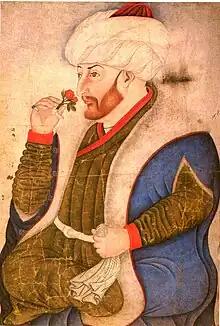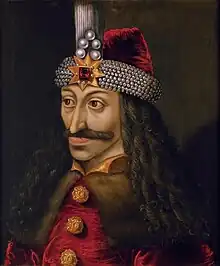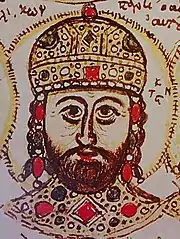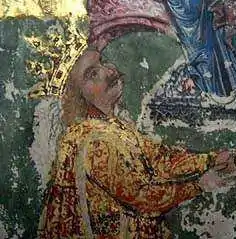Mehmed II's campaigns
This is a list of campaigns personally led by Mehmed II (30 March 1432 – 3 May 1481) (Ottoman Turkish: محمد ثانى, Meḥmed-i s̠ānī; Turkish: II. Mehmet; also known as el-Fātiḥ, الفاتح, "the Conqueror" in Ottoman Turkish; in modern Turkish, Fatih Sultan Mehmet; also called Mahomet II in early modern Europe) was Sultan of the Ottoman Empire twice, first for a short time from 1444 to September 1446, and later from February 1451 to 1481. At the age of 21, he conquered Constantinople and brought an end to the Byzantine Empire, transforming the Ottoman state into an empire. Mehmed continued his conquests in Asia, with the Anatolian reunification, and in Europe, as far as Bosnia and Croatia. Mehmed II is regarded as a national hero in Turkey, and Istanbul's Fatih Sultan Mehmet Bridge is named after him.
| Campaigns of Mehmed the Conqueror سفر همايون / Sefer-i humāyūn | |||||||
|---|---|---|---|---|---|---|---|
| Part of the Ottoman wars in Europe and the Ottoman wars in the Near East | |||||||
 Sultan Mehmed II smelling a rose, from the Sarayı Albums. Hazine 2153, folio 10a | |||||||
| |||||||
List of campaigns
Campaigns in Europe
Campaigns in Anatolia
| # | Campaign | Campaign dates | Notes |
|---|---|---|---|
| 1 | Karaman | 1451 | The Karamanids attacked Ottoman territory after Mehmed became sultan. In response sultan Mehmed made his first campaign against Karaman. The Karamanids were defeated and İbrahim II of Karaman promised not to attack the Ottomans again and so peace was restored. |
| 2 | Constantinople | 1453 | While sultan Mehmed was on his campaign against Karaman, the Byzantine emperor Constantine XI demanded an increase of the annual allowance to an Ottoman pretender in Constantinople. Mehmed refused and prepared to besiege Constantinople. He ordered the construction of the Rumeli Hisar after which the siege of the city began. The city was conquered following a siege lasting 53 days. The Byzantine Empire ceased to exist and the city became the new capital of the Ottoman Empire. |
| 3 | Kingdom of Hungary,Kingdom of Serbia | 1454-55 | Mehmed led a campaign against Serbia because the Serbian ruler Đurađ Branković refused to send tribute and made an alliance with the Kingdom of Hungary. The Ottoman army conquered the important mining city of Novo Brdo. |
| 4 | Kingdom of Hungary | 1456 | Mehmed continued his campaign against Hungary, numerous castles were captured but the Siege of Belgrade (1456) was unsuccessful and the Ottoman army retreated. |
| 5 | Serbia | 1458-59 | After the death of the Serbian ruler Đurađ Branković a succession war broke out and the sultan who was related to the Serbian kings invaded the area, Smederevo was captured and the Serbian Despotate ended and was annexed to the Ottoman Empire. (See History of the Serbian–Turkish wars) |
| 6 | Morea | 1458-59 | The Despotate of Morea refused to pay its annual tribute and revolted. In response Mehmed led a campaign into Morea. The inhabitants were defeated and their territories were annexed into the Ottoman Empire. |
| 7 | Amasra | 1460 | Amasra, the most important fortress of the Genoese on the Black Sea coast, was besieged and captured. |
| 8 | Sinop | 1461 | Mehmed led a campaign against Trebizond and on the way annexed the entire Black Sea coast to the Ottoman Empire ending the reign of the Jandarids peacefully. |
| 9 | Trebizond | 1461 | After the emperor of the Empire of Trebizond refused to pay tribute and made an alliance with the Akkoyunlu Mehmed led a campaign against Trebizond by land and sea. After a siege of more than 32 days, Trebizond and the emperor surrendered and the Empire came to an end. |
| 10 | Wallachia | 1462 | Vlad the Impaler who with Ottoman help had become the Ottoman vassal ruler of Wallachia, refused to pay tribute after some years and invaded Ottoman territory in northern Bulgaria. At that point, Mehmed, with the main Ottoman army, was on the Trebizond campaign in Asia. When Mehmed returned from his Trebizond campaign he invaded Wallachia. Vlad attacked Mehmed's camp near Târgoviște and failed to assassinate him. This would lead to Vlad fleeing from Wallachia and to the rise to the throne of his Ottoman-supported brother Radu as a vassal ruler. |
| 11 | Lesbos | 1462 | The island of Lesbos was captured following a siege of its capital, Mytilene, and annexed. |
| 12 | Bosnia | 1463-64 | Mehmed led a campaign against the Kingdom of Bosnia and annexed it to the Ottoman Empire |
| 13 | Morea | 1463 | Mehmed led a campaign in the Morea, which ended with the annexation of the Despotate of Morea. |
| 14 | Albania | 1466-67 | Mehmed led a campaign against Albania and besieged Krujë,but Albanian He resisted successfully. Mehmed transferred the siege to Mahmud Pasha and returned to Istanbul. |
| 15 | Karaman | 1468 | After the death of the ruler of Karamanids a civil war began among his sons in which Uzun Hasan, ruler of the Akkoyunlu, also became involved. After some time Mehmed marched into the area and annexed the Karamanids to the Ottoman Empire. |
| 16 | Negroponte | 1470 | During the long Ottoman–Venetian War (1463–1479). Mehmed led a campaign against the Venetian colony of Negroponte and after a siege annexed the region to the Ottoman Empire |
| 17 | Eastern Anatolia | 1473 | After many years of hostility Mehmed invaded the lands of the Akkoyunlu and defeated their ruler, Uzun Hasan, in the Battle of Otlukbeli, after which they did not pose a threat against the Ottomans anymore. |
| 18 | Moldavia | 1476 | Stephen III of Moldavia attacked Wallachia, an Ottoman vassal, and refused to pay the annual tribute. An Ottoman army was defeated in the Battle of Vaslui and Mehmed led a personal campaign against Moldavia. He defeated the Moldavians in the Battle of Valea Albă, after that he was defeated at Siege of Neamț Citadel. |
| 19 | Albania | 1478 | During the long Ottoman–Venetian War (1463–1479) Mehmed invaded Albania and besieged the Venetian fortress of Shkodra. The war ended in Venetian defeat and Shkodra was surrendered to the Ottomans in accordance with the Treaty of Constantinople (1479). |
Mehmed's opponents
 John Hunyadi (Campaign 3-4)
John Hunyadi (Campaign 3-4) Skanderbeg (Campaign 14)
Skanderbeg (Campaign 14) Vlad the Impaler (Campaign 10)
Vlad the Impaler (Campaign 10) Constantine XI (Campaign 2)
Constantine XI (Campaign 2) Stephen III of Moldavia (Campaign 18)
Stephen III of Moldavia (Campaign 18).jpg.webp) Cristoforo Moro (Campaign 16)
Cristoforo Moro (Campaign 16)
See also
References
Further reading
- History of the Ottoman Empire and Modern Turkey: Stanford Jay Shaw,Ezel Kural Shaw, 1977